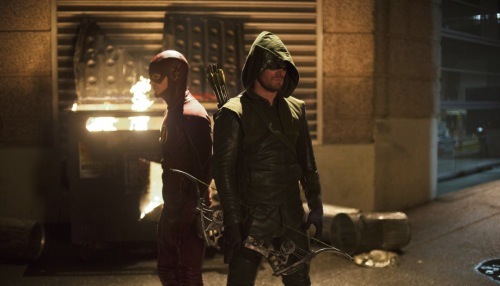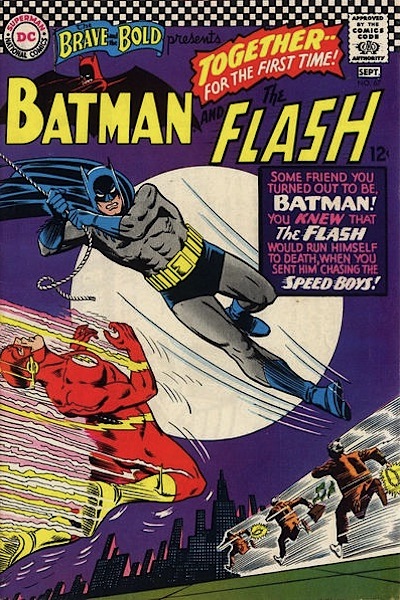The CW’s Flash/Arrow crossover last week was loads of fun.

Still from The Flash 1.08 “Flash vs. Arrow” © 2014 CW. Photo: Diyah Perra.
I’d like to get to full-on reviews of both shows this season, but my inner 6-year-old demands that my adult self acknowledge this super-cool undertaking now. Just seeing
a green arrow slice through The Flash’s usual title sequence on Tuesday night and a lightning bolt flash through Arrow’s on Wednesday put a big, goofy grin on my face.
“Flash vs. Arrow” and “The Brave and the Bold” — as the episodes were named, the latter after a long-running DC Comics team-up series — work individually. Although
the first does lead into the second, there’s no cliffhanger. So they’re really a pair of crossovers, meaning you can enjoy them separately if desired.
Since DC and Warner Bros. Entertainment have decided that the shared universe springing from Man of Steel doesn’t/won’t take place on “Earth-CW” — at least, I can hope, until the Crisis teased on Flash via a headline from the future displayed by STAR Labs’ enigmatic Dr. Harrison Wells comes to pass — The Flash (played by Grant Gustin) and The Arrow (Stephen Amell) are essentially their reality’s Superman and Batman: one an optimistic guardian angel with miraculous abilities, the other a fatalistic, non-powered streetwise vigilante with nifty gadgets and rigorous combat training. In the traditional DC mythos they’re specialists, riffs on the archetypes of archer and speedster; here the absence of their more iconic forebears elevates Oliver Queen and Barry Allen to premier status, inspirations and harbingers who may yet build a Justice League of their own.
Arrow and The Flash each have problems that I can’t dismiss simply because of the thrill I feel watching these heroes brought to life, entirely apart from how faithful they are or aren’t to their origins in print. The crossover episodes, in fact, shone a spotlight on some of the series’ inherent or ingrained problems. Mild spoiler warning before I dive into them, after a break to show readers who aren’t up on their comic-book lore the way Flash and [Green] Arrow were portrayed five decades ago on the covers of...


Covers of The Brave and the Bold #28 & The Brave and the Bold #67 © 1960, 1966 DC. Pencils: Mike Sekowsky (#28); Carmine Infantino (#67). Inks: Murphy Anderson (#28); Joe Giella (#67). Letters: Ira Schnapp (both). Colors: Unknown. Editing: Julius Schwartz.
The Brave and the Bold itself, which launched in 1955 offering adventure strips set in bygone eras, transitioned in 1959 to a tryout vehicle for new features, began teaming
up various established characters in 1963, and come 1968 was exclusively co-starring Batman with different partners every issue, finally ending its initial run in 1983.
Despite what the cover above right says, Batman and Flash had met before; still, it
was their first outing purely as a duo. They were charter members of the Justice League of America, which debuted in B&B #28, dated March 1960, during the title’s anthology phase — after three issues introducing the original Suicide Squad, a.k.a. Task Force X, whose later iterations as a cadre of super-criminals redirected for impossible missions by the government are the basis of the covert ARGUS group of that name on the CW shows and of a 2016 entry in DC’s film slate. Green Arrow didn’t join the JLA for another year, whereas a more recent creation known as the Manhunter from Mars, seen below left, was one of the ensemble’s founders along with Superman, Batman, Flash, Green Lantern, Aquaman, and Wonder Woman.
The Brave and Bold moniker has been resurrected by DC a number of times since
1983, among them for a 1999 miniseries set in the past starring Barry Allen and Hal Jordan, who’d been succeeded as Flash and Green Lantern by others on account of being dead (not permanently, it so happens, because comics and even more because marketing). Hal was fast friends with both Ollie and Barry in the comics but they were never close pals themselves. Given how unlikely a Green Lantern in Arrow/Flash-land feels at the moment, eliminating the middleman works for me. [Batman: The Brave and the Bold mining the vast DC library, aired from 2008 to 2011 on Cartoon Network; I reviewed its wonky finale.]


Covers of The Brave and the Bold #50 & The Brave and the Bold #71 © 1963, 1967 DC. Pencils: George Roussos (#50); Carmine Infantino (#71). Inks: Roussos (#50); Chuck Cuidera (#71). Letters: Ira Schnapp (#50); Gaspar Saladino (#71). Colors: Unknown. Editing: Julius Schwartz.
Arrow wants to have its cake and eat it too when it comes to how brutal its titular
hero is willing to be. Oliver assumed the roles of judge, jury, and executioner upon his return to Starling City in the first season in a way that makes it hard to accept him as a white knight — even harder to accept that the police force and prosecutor’s office accept him as such, a point raised in “Flash vs. Arrow” by CCPD Detective Joe West. I could not figure why the flashbacks during “The Brave and the Bold” to Ollie’s time in Hong Kong under the thumb of ARGUS director Amanda Waller showed him supposedly being taught why torture was necessary yet the here-and-now action in Starling City tugged in the opposite direction, and then in large part due to it being the last metaphorical arrow in Ollie’s quiver since, having vowed to stop killing, he couldn’t effectively threaten Boomerang’s life. Furthermore, and unconscionably, Waller motivated Oliver by telling him that the mass casualties were on his head because he didn’t elicit the explosives’ location from ARGUS’s captive soon enough; surely Waller had the wherewithal to do that herself or bring in operatives who could. Unless she was running a psychological game to motivate Oliver and nobody was actually harmed, of which we got zero indication, those deaths are on her.
Meanwhile, Barry takes the metahuman menaces in Central City too lightly, which his colleagues at STAR Labs admit during the crossover and for which Ollie takes Barry to task. It’s almost ironic given that fact to see Flash struggle against having Barry’s amazing powers trump nearly any situation, especially when oversight can’t be chalked up to his own naivety or inexperience. Even he isn’t able to be in several places literally at the same time, a lesson learned in the comics repeatedly, so it was smart of Barry to solve the climactic problem in “The Brave and the Bold” (and smart of the series to depict him doing so) by whisking members of the heroes’ support crews to the assorted bomb sites. What made no sense was Barry failing to smack Boomerang unconscious or tie him up in an instant — at the urging of the experienced, tactically minded Oliver, if nothing else — before zipping away instead of leaving Ollie to fight him.
Plus, Arrow is often a little too on the nose in terms of its flashbacks mirroring dilemmas in the present day, but putting Ollie in the position of engaging in torture to find the location of a bomb — just like he was that first time Waller decided he should acquire the skill — felt awkwardly equivalent. I really need to write more about these shows.

Still from Arrow 3.08 “The Brave and the Bold” © 2014 CW. Photo: Cate Cameron.
Oliver getting the better of Barry in the first of the episodes was nicely handled. Barry has been cocky and does spend too much time standing around to spar with a villain or loitering in what is potentially a trap after arriving on the scene instead of, as suggested by Oliver, casing the joint. And I simply love seeing these characters hang out in costume, bonding, comparing notes, however exciting the action sequences may be.
My enjoyment in watching Oliver and Barry’s partnership only makes me leerier of
the forthcoming Batman v. Superman: Dawn of Justice. “Flash vs. Arrow” has it beat already in its less-clinical abbreviation of versus, never mind the fun throwback reference of “The Brave and the Bold”. Batman v. Superman: Dawn of Justice is not the title of a movie based on comic books; it’s the title of a videogame based on a court case based on comic books.
DC’s big-screen Justice League franchise would do well to emulate the Flash/Arrow crossover vibe. I despair of it being more face-off than team-up, or at the rate that cast members and spinoffs have been announced merely all set-up, but that’s a topic of its own.
“Flash vs. Arrow” (written by Greg Berlanti & Andrew Kreisberg; directed by Glen Winter) brought Arrow to its highest ratings ever, with 3.9 million viewers and a 1.4 rating per Nielsen in the coveted 18-to-49 demographic. Ratings for “The Brave and the Bold” (written by Grainne Godfree & Marc Guggenheim from Berlanti & Kreisberg’s story; directed by Jesse Warn) matched those of Flash’s second episode as the next-most-watched telecast in CW history after the premiere, factoring in DVR usage within 7 days, with 4.2 million viewers and a 1.5 rating for 18-to-49. You can stream both episodes on Hulu as well as the CW website at this writing.

Still from Arrow 3.08 “The Brave and the Bold” © 2014 CW. Photo: Cate Cameron.
Flash airs its first mid-season finale tomorrow, Dec. 9th, at 8 p.m. on your local CW station; Arrow’s mid-season finale airs at 8 the following night, Dec. 10th. They’ll return with new episodes in 2015.
Related: Panel to Frame • Gloom and Doomsday
• One Flash, Two Flash, Red and Blue Flash

Late to the party here, but I've been working on getting caught up on both shows (Arrow S2 via Netflix, then my backlogged DVR of season 3, waiting on Flash til I hit the crossover episodes) and I finally made it past the crossover which was, as you say, mostly excellent.
ReplyDeleteYou're spot on in terms of how these two shows are effectively the Superman and Batman of DC's small screen universe - I got the same vibe especially from this crossover, particularly in the "I've got powers/I've got tactics and strategy" discussions.
Like you, it makes me worried (on top of existing worries) about the DC movie universe, as it seems that DC kinds of treats these shows as after thoughts, when they are in fact pretty much doing what I'd like to see the movies do, but on a grander scale with a larger budget.
In other words, the relationship between Barry and Ollie on these shows is almost exactly what I'd like to see in the relationship between Superman and Batman. But DC's willingless to let this relationship play out via (in their eyes) two lower tier characters on a lower tier platform (and their concern over presenting conflicting interpretations of characters across different mediums) makes me worried they have no interest in developing that kind of relationship between the cinematic Batman and Superman.
Plus, Arrow is often a little too on the nose in terms of its flashbacks mirroring dilemmas in the present day
Indeed. If anything, the flashback structure is probably my biggest gripe with the show. As much as it does occasionally parallel the events in the present elegantly, more often than not it's a clumsy thematic connection and little else.
I wouldn't want the show to ditch it entirely, because it can be useful (and there is some fun to be had in filling in Oliver's "island" years) but I would like to see them be more willing to occasionally abandon it than they are now.
And I simply love seeing these characters hang
out in costume, bonding, comparing notes, however exciting the action sequences
may be
Ditto.
Batman v. Superman: Rise of Justice is not the title of a movie based on comic books; it's the title of a videogame based
on a court case based on comic books.
Ha!